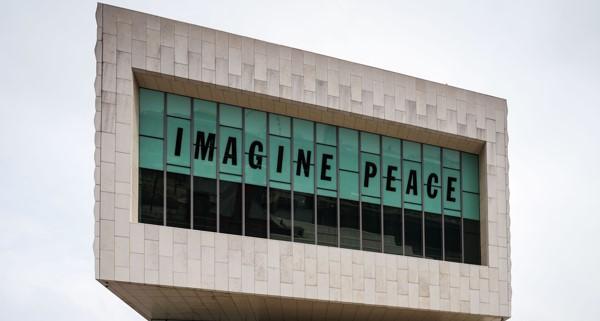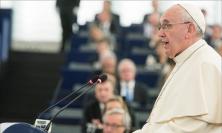The prospect of true peace is as bewildering and demanding as it is wonderful, says Theodora Hawksley. The same can be said of resurrection, and so the Easter story can speak daringly to us as we seek to understand what peacebuilding really looks like in a divided Britain. ‘Jesus’s greeting, “Peace be with you”, does not mean, “Let bygones be bygones”- so what does it mean?
The results of the European elections told us something that we already knew: this country is deeply divided. Pro-Brexit parties polled 34.9% of the vote, with assorted anti-Brexit parties polling 40.4%.[1] The results also showed major geographical divisions: by and large, the major urban areas in England voted for pro-remain or pro-second referendum parties, while the rest of the country voted for Brexit parties; mainland Scotland was solid SNP yellow. These stark divisions are part of the reason why Theresa May’s repeated pleas for the UK to ‘move forward together’, and her references to delivering ‘the Brexit that the British people voted for’ have rung hollow. We simply cannot ‘move forward together’ if, as a nation, we are split down the middle by radically different visions of the future and the best way to achieve it. In this context, politicians who urge unity are at risk of ‘dressing the wound of my people as though it were not serious. “Peace, peace,” they say, when there is no peace.’ (Jer 6:14). Theresa May is at least partly right: we do need peace and reconciliation, we need to address the fact of our divisions and the factors that, over the course of decades, have created and hardened them. But that reconciliation is not going to happen by ‘putting our divisions behind us’ and embracing a false unity: we need to put our divisions in front of us, and acknowledge just how demanding the challenge of peacebuilding is going to be.
Since Augustine, the Catholic Social Teaching tradition has upheld the conviction that ‘just as there is no-one who does not desire happiness, so there is no-one who does not desire peace.’[2] In Augustine’s hands, this claim is fairly equivocal – he notes that even bands of robbers desire peace among themselves, ‘so that they can invade the peace of others with greater safety.’[3] But in twentieth century Catholic Social Teaching on peace, the idea that all people desire peace has been understood in more straightforwardly positive terms: people are reasonable, able to identify what is good and to pursue it, and thus able to settle their differences without recourse to violence. Catholic Social Teaching also holds that the basic truth of human society is not conflict and class struggle, but harmony and cooperation: this, not constant strife, is what we are built for.[4] But even as these core convictions of Catholic Social Teaching hold before us an inspiring vision of the possibility of another kind of society, they can also lead us to underestimate just how difficult it is to get there. We may be built for harmony, but we are born into a world of violence and threat, and it inevitably shapes our moral horizons and habits. John Brewer, a peacebuilder working in Northern Ireland, writes this:
In our context of thirty plus years of troubles, violence, fear, and division are known. Peace is the mystery! People are frightened of peace. It is simultaneously exciting and fearful… Peace asks a lot of you. Peace asks you to share memory. It asks you to share space, territory, specific concrete places. It asks you to share a future. And all this you are asked to do with and in the presence of your enemy. Peace is mystery. It is walking into the unknown.[5]
Catholic Social Teaching is right: we do all desire peace, but in a world of division, threat and violence, the prospect of genuine peace is not necessarily inviting and easy. Instead, what we often desire and pursue is not the peace Brewer describes, with its demanding sharing of space, future and territory, but what Augustine calls ‘a peace of our own choosing’.[6]
It is here that I want to turn to the Easter story. We are now nearing the end of Eastertide, the fifty days that the Church gives us to absorb the joyful and utterly bewildering news that the crucified Jesus has risen from the dead. I want to suggest that resurrection, like peace, is something about which we are deeply ambivalent. On one hand, resurrection is something we desire very much: we want to escape death ourselves, and to have our loved ones returned to us, and we read poems at funerals about death being ‘nothing at all.’[7] According to one 2012 study, more people in the UK believe in life after death than believe in God – as a society, our desire for resurrection has even outlasted our theism.[8] On the other hand, we routinely terrify ourselves with stories about things coming back from the dead, or things that cannot be killed, whether vampires, zombies or viruses. The heroes of these stories are those who restore the universe to its rightful order by returning to the dead the things that belong there, but refuse to stay put. Small wonder, then, that the first words of the risen Christ to his companions are, ‘Do not be afraid,’ (Mt 28:10) and ‘peace be with you.’ (Lk 24:36) How heart-burstingly wonderful, that someone might return from death to greet us by name – and how heart-stoppingly terrifying. Resurrection is something that we deeply long for, and simultaneously something that frightens us very much. And so what we end up desiring, often, is a sort of pseudo-resurrection: either a death that is ‘nothing at all,’ and a life that resumes basically unchanged, or a kind of resurrected life that is really a resuscitation. We find it much harder to imagine – and much harder to desire – the absolute discontinuity of a real, final death, and a resurrection that is not a reversal of that death but, as Donald MacKinnon puts it, the beginning of a ‘strange and elusive sequel.’[9]
Peace, I want to suggest, is the same: faced with the frightening prospect of peace and what it may demand of us, we typically seek and settle for forms of pseudo-peace: the peace of division, which we gain by cutting off or killing what threatens us. On a personal level, we deal with our inner chaos by suppressing or projecting what disturbs us, whether it be guilt, failure, fears or memories of pain. From an early age, we learn to impose order on our inner world by sorting good from bad, acceptable from unacceptable, light from dark. The same pattern repeats itself on an interpersonal level: we pursue peace by division, cutting ourselves off from the demands and chaos of others and, when relationships are damaged beyond hope of repair, deploying death-as-solution and simply pretending that the other person no longer exists. On a societal level, too, we see our collective tendency to secure the peace and unity of our social group by identifying, othering, excluding or containing whatever is perceived as threatening it – the criminal, mentally ill, immigrant, the poor, or the politically, religiously or ethnically other. This pursuit of peace-by-division is often accompanied by a tactic as old as Eden – covering ourselves and blaming others. Thus, to ‘cover’ our feeling of being threatened, so that we cannot see it, we project our fear outwards onto the other and blame them for it: ‘She tempted me, so I ate,’ (Gen 3:12) becomes, ‘They are dangerous, and so we exclude them.’ In all of these situations, the return ‘from the dead’ of what we have cut off, whether in our own psyche, our social circle or our wider group, appears deeply threatening.
In this kind of ‘peace-by-division’ the dynamic at work is, ‘It is better that one man should die for the people’ (Jn 18:14). It is better for me, personally, to cut them off and pretend that they do not exist, because that way I can gain some peace of mind, and avoid encountering views I dislike. It is better for us as a social group to cut them off, and deny any relationship of reciprocity or responsibility, because that way we can gain security and prosperity. In pursuing peace-by-division in this way, we gain a ‘piecemeal peace’, but we also create victims. At this point, let me ask a direct question: by whose death have you purchased your peace? On a personal level, does your peace of mind at the moment depend on excluding, ignoring or disengaging from others? On a societal level, does your vision of a better future involve wishing away a certain percentage of the population? I suspect that, for most people, and for every political persuasion, there will be at least a partial ‘yes’ in answer to these questions. Desiring peace, after all, means wanting to avoid conflict, and therefore tending to disengage – many people feel exhausted by the Brexit conflict, and ill-equipped to engage with those with whom they disagree. But if we do want to ‘move forward’, or begin to face up to the deep divisions in our society, we cannot rest in our trenches permanently: we need to make the risky journey towards encountering those with whom we most deeply disagree.
It is here that the resurrection offers us a vision of a different way forward. In the evening on the first day of the week the disciples are holed up, the doors locked for fear of the Jews, when Jesus enters the room and stands among them. He appears there as what we dread: the return from the dead of what we have shut out or cut off. Jesus appears there not just as the one we crucify in dramatic or obvious ways, but as the one from whom we cut ourselves off in all kinds of understandable, ordinary and perhaps unavoidable ways – the one betrayed, the one abandoned, the one we could not love enough, the one we sacrificed because of our need for safety, or out of fear, the one whom it was better to sacrifice for a greater good, or to save ‘the people’. And Jesus appears there, too, as the reconciliation for which we long, but from which we have cut ourselves off, or which seems impossible. And he appears, in the locked room, not as reproach, condemnation or vengeance, but as forgiveness, healing and restoration: he comes with the greeting, ‘Peace be with you.’
What the risen Jesus holds out to us is the possibility of a different kind of peace: a peace that comes from encounter, rather than through division. Even if, as Catholic Social Teaching holds, we are made for harmony and not conflict, the encounter is difficult and demanding. It demands, first of all, the hard work of ‘admission’, in the sense of letting the other into the locked space of our security, or going beyond our usual boundaries or comfort-zones to seek them out. It also demands the hard work of ‘admission’ in another sense: the disciples must face the fact that they abandoned Jesus, and Peter that he denied him – Jesus’s greeting, ‘Peace be with you’, does not mean, ‘Let bygones be bygones.’ And risking encounter, as John Brewer points out, is a walk into the unknown: we cannot predict the outcome, and so it demands that we put our faith in the possibility of a ‘strange and elusive sequel.’ We need to ask what this means for us, as we contemplate the European election results, and look at the map of the profoundly divided UK. Who are we being asked to encounter, that perhaps we would rather not encounter? Whose stories are we being asked to hear? Whose presence or narrative do we need to ‘admit’, even if it conflicts with our own? Are we prepared to risk encounter in pursuit of our own, collective ‘elusive sequel’?
It may be objected that encountering the risen Jesus, the innocent victim, is one thing, and that encountering our enemy (though they may also be our victim), is something different. Encountering Jesus may not be comfortable, but he is not going to insult or injure us, and we are not going to end up the worse for the encounter. But perhaps the objection here contains the seed of an answer. First, although encountering the difficult other is not the same as encountering Jesus, it is not completely different, either: this person, whoever they are, bears the image of Christ and is part of his body. If we want to share in Jesus’s risen life, we cannot dispense with one another, and that means (minimally) holding open the possibility of encounter and relationship, not cutting ourselves off, or cutting others off. Second, the risen Jesus now has a life that can no longer be threatened by death: he cannot die again (Rom 6:9; Rev 1:18). Jesus does not need to protect himself from the potentially threatening other, and is therefore always open to and seeking out encounter, even in the face of rejection. Jesus’s resurrection is God’s insistence on life, in the face of our worst attempts to destroy it. It is true that we are human, mortal, not (or not yet) possessors of such an indestructible risen life; and it is true that, being human in a world of violence, we sometimes need to protect ourselves. But we can also pray for the grace to live out of Jesus’s risen and indestructible life, which will always seek out human beings in our fear and division, and offer us the possibility of a different kind of life together.
Theodora Hawksley is a theologian specialising in Catholic Social Teaching and peacebuilding. Her book What Makes for Peace: Catholic Social Teaching and Peacebuilding is forthcoming with the University of Notre Dame Press.
[1] BBC News, ‘European Elections 2019: Brexit Party dominates as Tories and Labour suffer.’ https://www.bbc.co.uk/news/uk-politics-48417228
[2] Augustine, The City of God against the pagans, edited and translated by R. W. Dyson (Cambridge: Cambridge University Press, 2001), XIX.12.
[3] Augustine, City of God, XIX.12.
[4] See Leo XIII, Rerum novarum, §19: ‘The great mistake made in regard to the matter now under consideration is to take up with the notion that class is naturally hostile to class, and that the wealthy and the working men are intended by nature to live in mutual conflict. So irrational and so false is this view that the direct contrary is the truth. Just as the symmetry of the human frame is the result of the suitable arrangement of the different parts of the body, so in a State is it ordained by nature that these two classes should dwell in harmony and agreement, so as to maintain the balance of the body politic. Each needs the other: capital cannot do without labour, nor labour without capital. Mutual agreement results in the beauty of good order, while perpetual conflict necessarily produces confusion and savage barbarity.’
[5] John Paul Lederach, ‘The Mystery of Transformative Times and Spaces: Exploring a Theology of Grassroots Peacebuilding’ in Mary Ann Cejka and Thomas Bamat, Artisans of Peace, (Maryknoll: Orbis Books, 2003), pp.256–267 (p.265).
[6] Augustine, City of God, XIX.12.
[7] The poem is by Henry Scott Holland: see https://www.poemhunter.com/poem/death-is-nothing-at-all/
[8] A. Sullivan, D. Voas and M. Brown, The Art of Asking Questions About Religion (London: Centre for Longitudinal Studies, 2012). This study reported that 31% of respondents believed in God, but 49% believed in life after death.
[9] Donald MacKinnon, ‘Subjective and Objective Conceptions of Atonement,’ in F. G. Healey (ed.), Prospect for Theology: Essays in Honour of H. H. Farmer, (Welwyn: James Nisbet & Co, 1996), pp.167–82 (p.173).






